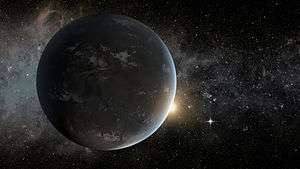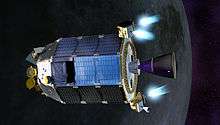2013 RF98
| Discovery[1] | |
|---|---|
| Discovered by | Dark Energy Survey (807) |
| Discovery date | 12 September 2013 |
| Designations | |
| MPC designation | 2013 RF98 |
| TNO | |
| Orbital characteristics[2] | |
|
Epoch 2016-Jul-31 (Uncertainty=5) | |
| Observation arc | 1092 days |
| Aphelion | 665 ± 21 AU (Q) |
| Perihelion | 36.10 0.04 AU (q) |
| 351 ± 11 AU | |
| Eccentricity | 0.897 ± 0.003 |
| 6569 ± 311 yr | |
| 0.370° ± 0.003° | |
| Inclination | 29.562° ± 0.003° |
| 67.608° ± 0.005° | |
| 311.8° ± 0.6° | |
| Physical characteristics | |
| Dimensions | ~50-110 km |
Spectral type | (moderately red) |
|
24.4 (2016) 28.8 (@100AU) | |
| 8.7 ± 0.3[2] | |
|
| |
2013 RF98 is a Trans-Neptunian object.[1] 2013 RF98 is part of the evidence for the Planet Nine hypothesis because it shares a similar Argument of perihelion with other potentially shepherded TNOs.
It came to perihelion (closest approach to the Sun) in November 2009 and was last observed in September 2016.[2] As of October 2016, it is 36.6 AU from the Sun. Of the seven objects whose aligned orbits suggest the existence of Planet Nine, it is currently the closest to the Sun. It will be 18.7 AU from Uranus in 2021. It will be in the constellation of Cetus until 2022. It comes to opposition at the start of November.
See also
- 90377 Sedna (relatively large and also distant body)
Notes
References
- 1 2 "List Of Centaurs and Scattered-Disk Objects". www.minorplanetcenter.org. Retrieved 22 January 2016.
- 1 2 3 "JPL Small-Body Database Browser: (2013 RF98)" (last observation: 2016-10-08; arc: 1092 days). Jet Propulsion Laboratory. Retrieved 2016-10-22.
External links
- JPL #2 Webcite archive of Epoch 2016-Jan-13 with 56-day observation arc
- 2013 RF98 at the JPL Small-Body Database

- MPEC 2016-U18: 2013 RF98
This article is issued from Wikipedia - version of the 11/1/2016. The text is available under the Creative Commons Attribution/Share Alike but additional terms may apply for the media files.
_(cropped).jpg)



